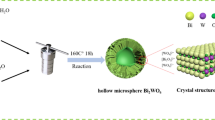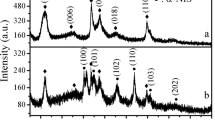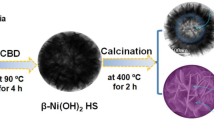Abstract
In this study, NaAlSiO4 hollow microspheres for Ni(II) and Cd(II) removal from wastewater were synthesized through a solvothermal method combined with calcination treatment. The hollow microspheres were characterized by SEM, TEM, DSC, XRD, FT-IR, and N2 adsorption/desorption analyzer. The average diameter of microspheres was approximately 2 ± 0.5 μm, and the average pore size was approximately 20 ~ 60 nm. The removal ability was evaluated under different conditions, including various pH values, metal ion concentrations, and adsorption times. Results show that the adsorption capacity of the NaAlSiO4 hollow microspheres depends on the surface area and the content of hexadecyl trimethyl ammonium bromide for Ni(II) and Cd(II), respectively. The maximum adsorption capacity calculated from Langmuir models was 297.11 mg/g for Ni(II) and 449.71 mg/g for Cd(II). The adsorption isotherm and kinetic fitting preferably agree with the Langmuir isotherm model with monolayer coverage. The Ni(II) adsorption efficiency was still more than 95% (Cd(II) adsorption efficiency significantly decreased to 23%) after four cycles, suggesting the high reusability of the hollow microspheres for Ni(II). The successful removal of Ni(II) and Cd(II) from water samples demonstrates the great potential of the proposed NaAlSiO4 to remediate Ni(II) and Cd(II) polluted water in environmental remediation.








Similar content being viewed by others
Data Availability
No datasets were generated or analysed during the current study.
References
Adham Ahmed RC, Willneff E, Ritchie H,Peter, Myers H, Zhang (2010) Synthesis of uniform porous silica microspheres with hydrophilic polymer as stabilizing agent. Ind. Eng. Chem. Res. 49: 602–608. https://doi.org/10.1021/ie901213v
Adnan M, **ao B, **ao P et al (2022) Research progress on heavy metals pollution in the soil of smelting sites in China. Toxics 10:231. https://doi.org/10.3390/toxics10050231
Ahmad Z, Li Y, Huang C et al (2021) Underwater suspended bifunctionalized polyethyleneimine-based sponge for selective removal of anionic pollutants from aqueous solution. J Hazard Mater 412:125284. https://doi.org/10.1016/j.jhazmat.2021.125284
An F, Wu R, Li M et al (2017) Adsorption of heavy metal ions by iminodiacetic acid functionalized D301 resin: kinetics, isotherms and thermodynamics. Reactive Funct Polym 118:42–50. https://doi.org/10.1016/j.reactfunctpolym.2017.07.005
An Y, Zheng H, Yu Z et al (2020) Functioned hollow glass microsphere as a self-floating adsorbent: Rapid and high-efficient removal of anionic dye. J Hazard Mater 381:120971. https://doi.org/10.1016/j.jhazmat.2019.120971
Awual MR (2019) A facile composite material for enhanced cadmium(II) ion capturing from wastewater. J Environ Chem Eng 7:103378. https://doi.org/10.1016/j.jece.2019.103378
Awual MR, Rahman IMM, Yaita T et al (2014) pH dependent cu(II) and pd(II) ions detection and removal from aqueous media by an efficient mesoporous adsorbent. Chem Eng J 236:100–109. https://doi.org/10.1016/j.cej.2013.09.083
Awual MR, Hasan MM, Iqbal J et al (2020) Ligand based sustainable composite material for sensitive nickel(II) capturing in aqueous media. J Environ Chem Eng 8:103591. https://doi.org/10.1016/j.jece.2019.103591
Benalia MC, Youcef L, Bouaziz MG et al (2021) Removal of heavy metals from industrial wastewater by chemical precipitation: mechanisms and sludge characterization. Arab J Sci Eng 47:5587–5599. https://doi.org/10.1007/s13369-021-05525-7
Beniamino Y, Cenni V, Piccioli M et al (2022) The ni(II)-binding activity of the intrinsically disordered region of human NDRG1, a protein involved in cancer development. Biomolecules 12:1272. https://doi.org/10.3390/biom12091272
Boumediene M, Benaissa H, George B et al (2015) Characterization of two cellulosic waste materials (orange and almond peels) and their use for the removal of methylene blue from aqueous solutions. Maderas-Ciencia Y Tecnologia 17:69–84. https://doi.org/10.4067/s0718-221x2015005000008
Cai W, Dionysiou DD, Fu F et al (2020) CTAB–intercalated molybdenum disulfide nanosheets for enhanced simultaneous removal of cr(VI) and ni(II) from aqueous solutions. J Hazard Mater 396:122728. https://doi.org/10.1016/j.jhazmat.2020.122728
Chen YY, Yu SH, Jiang HF et al (2018) Performance and mechanism of simultaneous removal of cd(II) and Congo Red from aqueous solution by hierarchical vaterite spherulites. Appl Surf Sci 444:224–234. https://doi.org/10.1016/j.apsusc.2018.03.081
Damiri F, Andra S, Kommineni N et al (2022) Recent advances in adsorptive nanocomposite membranes for heavy metals ion removal from contaminated water. Compr Rev Mater 15:5392. https://doi.org/10.3390/ma15155392
Dawodu FA, Akpomie KG (2014) Simultaneous adsorption of Ni(II) and mn(II) ions from aqueous solution unto a Nigerian kaolinite clay. J Mater Res Technology-Jmr&T 3:129–141. https://doi.org/10.1016/j.jmrt.2014.03.002
Debnath S, Ghosh UC (2009) Nanostructured hydrous titanium(IV) oxide: synthesis, characterization and ni(II) adsorption behavior. Chem Eng J 152:480–491. https://doi.org/10.1016/j.cej.2009.05.021
Dou J, Gan D, Huang Q et al (2019a) Functionalization of carbon nanotubes with chitosan based on MALI multicomponent reaction for Cu2+ removal. Int J Biol Macromol 136:476–485. https://doi.org/10.1016/j.ijbiomac.2019.06.112
Dou J, Huang Q, Huang H et al (2019b) Mussel-inspired preparation of layered double hydroxides based Polymer composites for removal of copper ions. J Colloid Interface Sci 533:416–427. https://doi.org/10.1016/j.jcis.2018.08.064
Gong J, Feng J, Liu J et al (2014) Catalytic carbonization of polypropylene into cup-stacked carbon nanotubes with high performances in adsorption of heavy metallic ions and organic dyes. Chem Eng J 248:27–40. https://doi.org/10.1016/j.cej.2014.01.107
Guo R, Bao Y, Kang Q et al (2022a) Solvent-controlled synthesis and photocatalytic activity of hollow TiO2 microspheres prepared by the solvothermal method. Colloids Surf a 633:127931. https://doi.org/10.1016/j.colsurfa.2021.127931
Guo S, Liu Y, Zhang W et al (2022b) N-doped carbon fibers in situ prepared by hydrothermal carbonization of Camellia sinensis branches waste for efficient removal of heavy metal ions. Environ Sci Pollut Res 29:88951–88961. https://doi.org/10.1007/s11356-022-21923-2
Hu X, Yan L, Wang Y et al (2021) Ion-imprinted sponge produced by ice template-assisted freeze drying of salecan and graphene oxide nanosheets for highly selective adsorption of mercury (II) ion. Carbohydr Polym 258:117622. https://doi.org/10.1016/j.carbpol.2021.117622
Islam MA, Awual MR, Angove MJ (2019) A review on nickel(II) adsorption in single and binary component systems and future path. J Environ Chem Eng 7:103305. https://doi.org/10.1016/j.jece.2019.103305
** J, Yang L, Chen F et al (2022) Drug delivery system based on nanobubbles. Interdisciplinary Mater 1:471–494. https://doi.org/10.1002/idm2.12050
Karim MR, Aijaz MO, Alharth NH et al (2019) Composite nanofibers membranes of poly(vinyl alcohol)/chitosan for selective lead(II) and cadmium(II) ions removal from wastewater. Ecotoxicol Environ Saf 169:479–486. https://doi.org/10.1016/j.ecoenv.2018.11.049
Khatun J, Intekhab A, Dhak D (2022) Effect of uncontrolled fertilization and heavy metal toxicity associated with arsenic(as), lead(pb) and cadmium (cd), and possible remediation. Toxicology 477:153274. https://doi.org/10.1016/j.tox.2022.153274
Kusworo TD, Kumoro AC, Aryanti N et al (2021) Removal of organic pollutants from rubber wastewater using hydrophilic nanocomposite rGO-ZnO/PES hybrid membranes. J Environ Chem Eng 9:106421. https://doi.org/10.1016/j.jece.2021.106421
Liang S, Shen L, Zhou C et al (2020) Scalable preparation of hollow ZrO2 microspheres through a liquid-liquid phase reunion assisted sol-gel method. Ceram Int 46:14188–14194. https://doi.org/10.1016/j.ceramint.2020.02.227
Liu Y, Guo L, Huang H et al (2019) Facile preparation of magnetic composites based on carbon nanotubes: utilization for removal of environmental pollutants. J Colloid Interface Sci 545:8–15. https://doi.org/10.1016/j.jcis.2019.03.009
Liu Y, Li X, Wang Y et al (2020) Hydrothermal synthesis of Au@SnO2 hierarchical hollow microspheres for ethanol detection. Sens Actuators B 319:128299. https://doi.org/10.1016/j.snb.2020.128299
Liu C, Liu N, Li X et al (2022) Adsorption of cd(II) on mesoporous Al2O3 prepared from high-aluminum fly ash. Mater Res Express 9:065502. https://doi.org/10.1088/2053-1591/ac7383
Lv Y, Yang L, Wang J et al (2022) Performance of ultra-high-performance concrete incorporating municipal solid waste incineration fly ash. Case Stud Constr Mater 17:e01155. https://doi.org/10.1016/j.cscm.2022.e01155
Malayoglu U (2018) Removal of heavy metals by biopolymer (chitosan)/nanoclay composites. Sep Sci Technol 53:2741–2749. https://doi.org/10.1080/01496395.2018.1471506
Mao S, Gao M (2021) Functional organoclays for removal of heavy metal ions from water: a review. J Mol Liq 334:116143. https://doi.org/10.1016/j.molliq.2021.116143
Monier M, Ayad DM, Wei Y et al (2010) Adsorption of Cu(II), Co(II), and Ni(II) ions by modified magnetic chitosan chelating resin. J Hazard Mater 177:962–970. https://doi.org/10.1016/j.jhazmat.2010.01.012
Ong DC, **ul-Ong SMB, Kan C-C et al (2018) Removal of nickel ions from aqueous solutions by manganese dioxide derived from groundwater treatment sludge. J Clean Prod 190:443–451. https://doi.org/10.1016/j.jclepro.2018.04.175
Punia P, Bharti MK, Dhar R et al (2022) Recent advances in detection and removal of heavy metals from contaminated water. ChemBioEng Reviews 9:351–369. https://doi.org/10.1002/cben.202100053
Qiao Y, Li Q, Li Q et al (2022) Lightweight epoxy foams prepared with arranged hollow-glass-microspheres/epoxy hollow spheres. Compos Commun 33:101197. https://doi.org/10.1016/j.coco.2022.101197
Rajurkar NS, Gokarn AN, Dimya K (2011) Adsorption of chromium(III), nickel(II), and copper(II) from aqueous solution by activated alumina. Clean-Soil Air Water 39:767–773. https://doi.org/10.1002/clen.201000273
Razzak SA, Faruque MO, Alsheikh Z et al (2022) A comprehensive review on conventional and biological-driven heavy metals removal from industrial wastewater. Environ Adv 7:100168. https://doi.org/10.1016/j.envadv.2022.100168
Rostamian R, Najafi M, Rafati AA (2011) Synthesis and characterization of thiol-functionalized silica nano hollow sphere as a novel adsorbent for removal of poisonous heavy metal ions from water: kinetics, isotherms and error analysis. Chem Eng J 171:1004–1011. https://doi.org/10.1016/j.cej.2011.04.051
Salihi EÇ, Wang J, Coleman DJL et al (2016) Enhanced removal of nickel(II) ions from aqueous solutions by SDS-functionalized graphene oxide. Sep Sci Technol 51:1317–1327. https://doi.org/10.1080/01496395.2016.1162172
Salman MS, Sheikh MC, Hasan MM et al (2023) Chitosan-coated cotton fiber composite for efficient toxic dye encapsulation from aqueous media. Appl Surf Sci 622:157008. https://doi.org/10.1016/j.apsusc.2023.157008
Samad SA, Arafat A, Ferrari R et al (2021) Adsorption studies and effect of heat treatment on porous glass microspheres. Int J Appl Glass Sci 13:63–81. https://doi.org/10.1111/ijag.16352
Sheikh MC, Hasan MM, Hasan MN et al (2023) Toxic cadmium(II) monitoring and removal from aqueous solution using ligand-based facial composite adsorbent. J Mol Liq 389:122854. https://doi.org/10.1016/j.molliq.2023.122854
Song P, Xu D, Yue J et al (2022) Recent advances in soil remediation technology for heavy metal contaminated sites: a critical review. Sci Total Environ 838:156417. https://doi.org/10.1016/j.scitotenv.2022.156417
Tang Y, Liang S, Wang J et al (2013) Amino-functionalized core-shell magnetic mesoporous composite microspheres for pb(II) and cd(II) removal. J Environ Sci 25:830–837. https://doi.org/10.1016/s1001-0742(12)60141-7
Tang T, Han C, Deng J et al (2022) Controllable preparation of thio-functionalized composite polysilsesquioxane microspheres in a microreaction system. Adv Powder Technol 33:103578. https://doi.org/10.1016/j.apt.2022.103578
Thévenod F, Lee W-K (2013) Toxicology of cadmium and its damage to mammalian organs: Cadmium: From Toxicity to Essentiality (ed., pp. 415–490
Velusamy S, Roy A, Sundaram S et al (2021) A review on heavy metal ions and containing dyes removal through graphene oxide-based adsorption strategies for textile wastewater treatment. Chem Record 21:1570–1610. https://doi.org/10.1002/tcr.202000153
Vereshchagina TA, Kutikhina EA, Chernykh YY et al (2018) One-step immobilization of cesium and strontium from alkaline solutions via a facile hydrothermal route. J Nucl Mater 510:243–255. https://doi.org/10.1016/j.jnucmat.2018.08.015
Waliullah RM, Rehan AI, Awual ME et al (2023) Optimization of toxic dye removal from contaminated water using chitosan-grafted novel nanocomposite adsorbent. J Mol Liq 388:122763. https://doi.org/10.1016/j.molliq.2023.122763
Wang Y, Yao L, Xu L et al (2021) One-step solvothermal synthesis of hierarchical WO3 hollow microspheres with excellent NO gas sensing properties. Mater Lett 302:130460. https://doi.org/10.1016/j.matlet.2021.130460
Wang L, Tan X, Zhu Q et al (2022a) The universality applications of MoS2@MnS heterojunction hollow microspheres for univalence organic or multivalence aqueous electrolyte energy storage device. J Power Sources 518:230747. https://doi.org/10.1016/j.jpowsour.2021.230747
Wang Y, Chen F, Han W et al (2022b) Carbothermal synthesis of zirconium carbide hollow microspheres from polyzirconoxane and phenolic resin by spray drying. Ceram Int 48:2793–2801. https://doi.org/10.1016/j.ceramint.2021.10.068
Wu J-M, Li M, Liu S-S et al (2021) Selective laser sintering of porous Al2O3-based ceramics using both Al2O3 and SiO2 poly-hollow microspheres as raw materials. Ceram Int 47:15313–15318. https://doi.org/10.1016/j.ceramint.2021.02.096
Wu H, Jiang A, Li M et al (2022) Preparation of core-shell-structured RDX@PVDF microspheres with improved thermal stability and decreased mechanical sensitivity. Polymers 14:4262. https://doi.org/10.3390/polym14204262
**ong C, Wang W, Tan F et al (2015) Investigation on the efficiency and mechanism of cd(II) and pb(II) removal from aqueous solutions using MgO nanoparticles. J Hazard Mater 299:664–674. https://doi.org/10.1016/j.jhazmat.2015.08.008
Xu P, Nan Z, Zhu A et al (2017) A facile method for preparation of hollow mesoporous silica sphere and its application. Mater Lett 205:20–23. https://doi.org/10.1016/j.matlet.2017.06.045
Yan S, Zhang F, Wang L et al (2019) A green and low-cost hollow gangue microsphere/geopolymer adsorbent for the effective removal of heavy metals from wastewaters. J Environ Manage 246:174–183. https://doi.org/10.1016/j.jenvman.2019.05.120
Yang W, Tang Q, Wei J et al (2016) Enhanced removal of cd(II) and pb(II) by composites of mesoporous carbon stabilized alumina. Appl Surf Sci 369:215–223. https://doi.org/10.1016/j.apsusc.2016.01.151
Yuan X, Luo F, Chen X et al (2022) Effective cu(II) ions adsorption from aqueous solutions using low grade oolitic hematite tailing with phosphorus: response surface methodology. Desalination Water Treat 265:57–70. https://doi.org/10.5004/dwt.2022.28594
Yun-Kai Lu X-PY (2004) An imprinted organic inorganic hybrid sorbent for selective separation of cadmium from aqueous solution. Anal Chem 76:453–457. https://doi.org/10.1021/ac0347718
Zhang X, Wang X (2015) Adsorption and desorption of nickel(II) iions from aqueous solution by a lignocellulose/montmorillonite nanocomposite. PLoS ONE 10:e0117077. https://doi.org/10.1371/journal.pone.0117077
Zhang F, Wang B, He S et al (2014) Preparation of graphene-oxide/polyamidoamine dendrimers and their adsorption properties toward some heavy metal ions. J Chem Eng Data 59:1719–1726. https://doi.org/10.1021/je500219e
Acknowledgements
This work was financially supported by the National Key Research and Development (R&D) Program of China (No. 2018YFB1105702).
Author information
Authors and Affiliations
Contributions
Z.O. and L.M. carried out the experiments and wrote the main manuscript text. Y.H., W.L., F.Z., B.X., Z.Z., S.C., M.W. checked the data and figures. Q.W. supervised the whole project and revised the manuscript. All authors reviewed the manuscript.
Corresponding author
Ethics declarations
Competing Interests
The authors declare no competing interests.
Additional information
Publisher’s Note
Springer Nature remains neutral with regard to jurisdictional claims in published maps and institutional affiliations.
Rights and permissions
Springer Nature or its licensor (e.g. a society or other partner) holds exclusive rights to this article under a publishing agreement with the author(s) or other rightsholder(s); author self-archiving of the accepted manuscript version of this article is solely governed by the terms of such publishing agreement and applicable law.
About this article
Cite this article
Ouyang, Z., Meng, L., Hu, Y. et al. Synthesis of NaAlSiO4 Hollow Microspheres as Absorbents for the Removal of Heavy Metal Ions from Wastewater. Environ. Process. 11, 38 (2024). https://doi.org/10.1007/s40710-024-00715-5
Received:
Accepted:
Published:
DOI: https://doi.org/10.1007/s40710-024-00715-5




